INSTITUTE OF PHILOSOPHY OF NATURE
Abstract
The ionosphere is an electrified part of the Earth’s atmosphere, which is located around 50km-600km from the Earth’s surface. The ionosphere is composed of electrically charged particles that are ionized by a process called photoionization. The photoionization is produced mainly by solar radiation. The ionosphere is divided into three regions or layers: D- layer (48 km to 90 km), E-layer (90 km to 150 km) and F-layer (150 km to more than 500 km).
Many of the ionospheric features are not well understood. For example, the formation of a peak electron density around mid-night is not in coherence with the ionospheric theory that considers production of ions by photo ionization, loss of electrons by recombination and mobility of charge particles. Again, the newly identified alternately charged ionospheres cannot possibly be explained by the existing ionospheric theory. Further the correlation of distances of charge shells is beyond the scope of analysis by the present theory. This article proposes a new theory for explaining the ionospheric structure and feature including the alternate charge polarity of ionospheric shells considering charge polarization. It may be seen from this article that the new concept has a better stand in explaining many aspects of ionosphere and the mechanism is extendable to other planets. Distant planets having prominent ionospheric shells in spite of low-intensity solar radiation can be understood through the new proposed mechanism.
key words: ionosphere formation, photo ionization, electric field in atmosphere. Charge polarization in ionosphere.
Introduction
The atmosphere containing sufficient free electrons and ions is known as ionosphere. The ionosphere is well perceived between 60 km to 600 km of altitude with identified D, E, F1, F2 layers. According to the existing concept, the ionizing solar radiation entering the upper thin atmosphere penetrates deeper and deeper where it encounters greater and greater density of gas and produces more and more electrons per unit volume. The radiation, however, is absorbed in the photoelectric process. Thus, below a certain height the rate of production of electron decreases. Hence, there is a level at which, the rate of production is highest. This consideration of peak electron density in ionosphere assumes the simplified form of one class of ionizing radiation from the sun and one type of gas with a single ionizing potential. In reality, the problem is much more complicated with the solar spectrum spreading over a wide range of wavelengths and the atmosphere containing many gases. While the production of electrons by photo-ionization goes on, the loss of electrons also constantly in progress by recombination, attachment and migration. Thus, the net electron density in ionosphere is decided by the dynamic equilibrium of both ionization and the loss processes. As on today this is the only model available to understand the formation of ionosphere. There are many limitations of this ionospheric theory [1]. For example, why should there be a mid-night peak of electron density?; how can the ionospheric shells be alternately charged [2]?; why the recombination and attachment coefficients are not consistent during the mid-day bite and during the eclipse?; why the night sky is not bright due to recombination process?; why should there be an unevenness in the peak electron density in D-region?; why should there be a shift in the mid-day peak towards the afternoon?; why should the ionosphere experience a vertical movement (an excursion of 1 km) in E-layer with a period of half lunar day?; why the meteor based ionization is confined to a narrow belt around 105 km?; what makes the sub-layers in different ionospheric layers to form?; how a stronger ionization is possible in Jupiter with a low density solar radiation? Etc. The existing ionospheric theory does not explain the upper ionospheric shells such as the formation of Van Allen belt, magnetospheric belt. We have made use of different theories to explain the same. The formation of mid-night electron density peak clearly reveals that the photo-ionization process is not the only basis of formation of ionosphere. Further it is difficult to predict the newly identified alternate charge polarity of successive ionospheric shells from the present theory. Thus, the author takes the view that the ions and electrons coming in the solar wind and those produced by photo ionization organizes a typically earth based polarized structure and further the organized structure undergoes modification with solar-terrestrial relationship.
A New Concept of Ionospheric Charge Shells
Erman (1804) theorized that the Earth was negatively charged, and Peltier (1842) tested and confirmed Erman’s idea [3]. Atmospheric electricity is always present, and during fine weather away from thunderstorms, the air above the surface of Earth is positively charged, while the Earth’s surface charge is negative. The Earth has a vertical electric field of about 100 volts per meter (V/m) near the surface, which decreases with altitude [3]. The global air electric current magnitude is 1800 amperes (A) across the entire planet. The current is caused by the potential difference of 400 kV between the top of the atmosphere and the surface, which is due to the low conductivity of the lower atmosphere [4]. The surface of the earth and the ionospheric shells are found to be electrically charged [2]. The surface of the earth being negatively charged attracts the positive ions and repels the negative ions and free electrons in the ionosphere. The negative ions and free electrons are repelled by negative charge of earth’s surface but they are attracted by gravity of the earth. On the other hand, the positive charges are attracted by gravity as well as attracted by the negative charge of the earth’s crust. Closer to the surface of the earth, the charge repulsion to negative ions and free electrons are much stronger as compared to the gravitational attraction. This makes the negative ions and free electrons to move away of the earth’s surface and positive charges move towards the earth causing the air-earth current. Moving away from the surface of the earth, we notice that, the charge repulsion forces drop more rapidly than the attraction due to gravity. At some height (say 96 km) the charge repulsion and gravitational attraction becomes equal and opposite and electrons find a stable site at this height (Fig.1). Beyond this distance, the gravity force becomes stronger than the charge repulsion from the earth. Hence, all higher up negative charges move downward and settle down at 96 km. This makes a stable negatively charged ionospheric shell. Once the first negatively charged ionospheric shell is formed at 96 km it would organize and form one more negatively charged ionospheric shell at higher altitude following the same logic. Likewise, many more negatively charged ionospheric shells are formed one over the other as far as the gravity field of earth is dominant in space (Fig.2). The negatively charged shells in the ionosphere will not remain idle, they however, will organize positively charged shells in between the negatively charged shells due to equipotential attraction from the negatively charged shells. Thus, the entire ionospheric shell structure is formed with alternate positive and negative polarity (Fig.3). We shall further see how this shell structure is deformed by the charge attraction/repulsion from the sun.
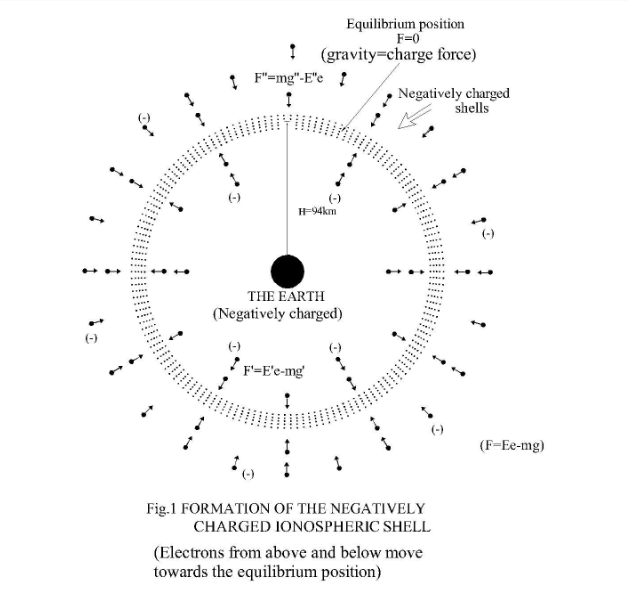
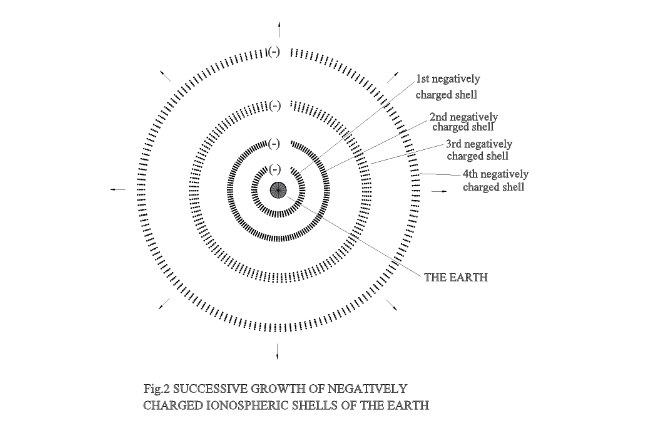
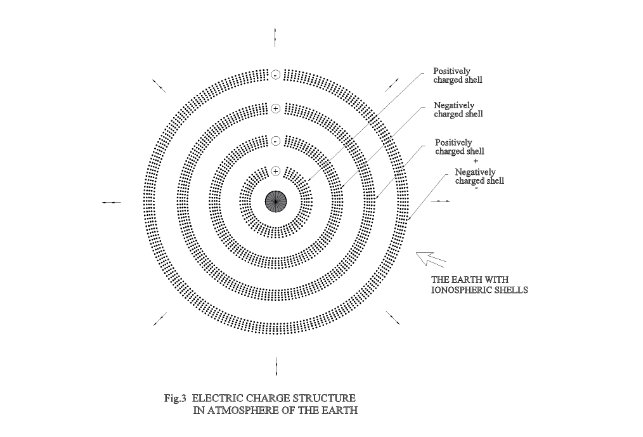
There is no direct evidence about the charge state of the sun. The author has suggested elsewhere [5] that the sun is positively charged. The positive charge of the sun also appears justified from the following logic. If the orbital body such as the earth in solar system is negatively charged similar to orbital electron in atomic system, then, there is every chance that the nucleus of the solar system (the sun) be positively charged in the light of the positively charged atomic nucleus. This new concept may now be put to a test-experiment in understanding the ionospheric features. If the sun is positively charged then it would exert coulombic forces on ionospheric charge particles in earthly organized ionospheric shells. The charge particles in the ionospheric shells are relatively free to move within the charged shells, but their movements across the shells are restrained by the polarization field barrier and the dielectric constant of space medium in between the ionospheric shells. Thus, the free electrons in the negatively charged ionospheric shells will experience charge attraction from the sun which will make them move within the respective shells to crowd at points nearest to the sun that corresponds to the mid-day sky (Fig.4). On the other hand, the positive ions in the positively charged ionospheric shells are pushed away of the sun making a crowding at points farthest from the sun that corresponds to the mid-night sky (Fig.4). The crowding of electrons and negative ions in negatively charged ionospheric shells in the mid-day sky would attract the positive ions in the positively charged ionospheres to accumulate in the mid- day sky. Likewise, the negative ions are also congregated in negatively charged ionospheric shells in the mid-night sky due to the crowding of positive ions in the positively charged ionospheric shells (Fig.5). This new consideration provides an alternate explanation to the formation of ionospheres having the charge density peaks during mid-day and mid-night sky. The existing concept of formation of ionospheric peaks by photoionization process alone has limitation in explaining the conspicuous charge density peak in the mid-night sky, when the ionizing solar radiation is absent. Though the ionospheric shell structure is organized by polarization, the ionization and recombination processes are primary. This is why the electron density drops down in the night time. The ionization is maximum at mid-day but the rate of ionisation remains higher than the loss process till mid-afternoon. This makes the maximum electron density (charge density) due to combined polarization and ionization to shift towards the afternoon. So far, we have been considering the negatively charged particles of one value of e/m. In reality, wide ranges of negatively charged particles with different e/m values are present in the atmosphere. Obviously they find stratification at different height from the consideration of gravity and charge forces. For this reason, the dust particles are stratified at 105 km (meteor belt) and at other levels. If one ignores the charge forces, he would find that gravity forces are sometimes increasing and some other times decreasing (in space) than the predicted values. Some have gone ahead in their thought for the anticipation of the 5th force without realizing the effect of the existing charge forces.
Besides the effect of the sun, other celestial bodies remaining at different charge states would make changes in the configuration and morphology of the earth-based ionospheric charge shells. The moon being very close to the earth can produce a significant effect. This explains why the ionosphere undergoes an excursion of about 1 kilometre with a period of half lunar day.
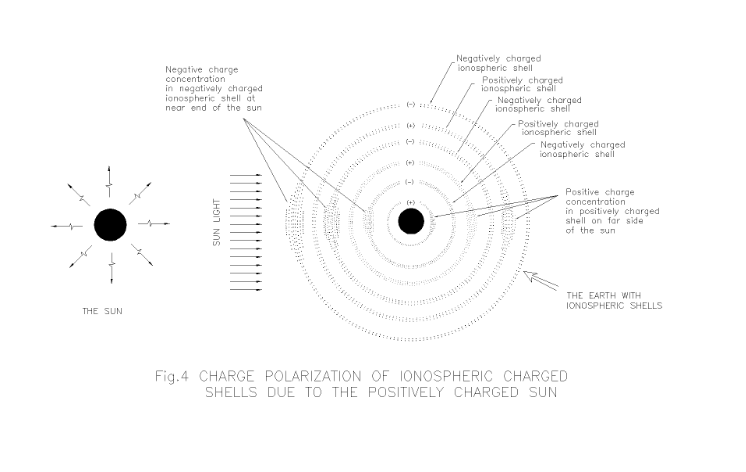
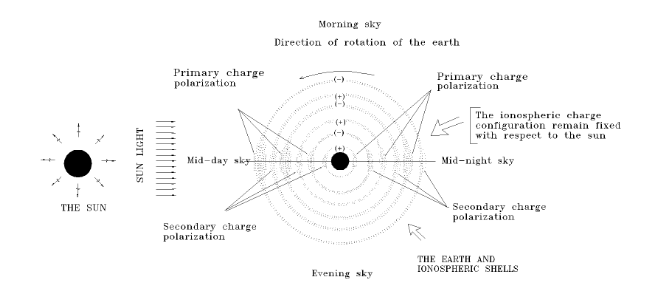
The recombination process is fast in neutral plasma but it becomes slow in polarized state with variation in the number density of negative and positive charges. For this reason, the recombination coefficient in ionosphere is different from neutral plasma. Many less understood ionospheric phenomena can be explained in a natural manner [2]. The spacings of the shells are seen to go on expanding outwardly. One may find a simple logic for this. The equilibrium position of a charge particle is decided by the gravity and the coulombic charge forces. The force of gravity goes on decreasing with distance following an inverse square law. Thus, the spacings of successive ionospheric charge shells are likely to increase in some GP series as observed.
Conclusion
The earth and its atmosphere are found to be electrically charged. The charge features of the earth is not considered in ionospheric theory. This paper explains the structure and feature of ionosphere of the earth including various anomaly by considering the negative charge of the earth and the positive charge of the sun. The ionospheres of other planets can be analysed by considering their negative charge states and the positive charge state of the sun. We notice here, like the atomic system the nucleus of solar system is positively charged and the planets are negatively charged. What a remarkable resemblance? The charge property of celestial bodies has a new scope of understanding the magnetism of the earth and the sun. Further the charge aspect of celestial bodies has scope to provide a better understanding of geomagnetism and auroral events. The author is optimistic for a unified dynamic for systems in micro and macro domains.
This article is a part of the original work published in the book “Planetary electrodynamics-I”, Volume-1 of the series “Dynamics of universe; interplay of matter, space and charge”, 1998 by the same author.
References
- Ratcliffe, J.A. and Weekes, K., in `Physics of the upper atmosphere’, Ed-JA Ratcliffe 3rd printing 1972, Academic Press, New York, Ch.9, p.421.
- https://philosophyofnature.org.in/similar-state-of-matter-of-nuclei-in-different-domains.
- https://en.wikipedia.org/wiki/Atmospheric_electricity.
- https://en.wikipedia.org/wiki/Global_atmospheric_electrical_circuit#:~:text=The%20voltages%20involved%20in%20the,A%20over%20the%20entire%20planet.
- https://philosophyofnature.org.in/similar-state-of-matter-of-nuclei-in-different-domains.
